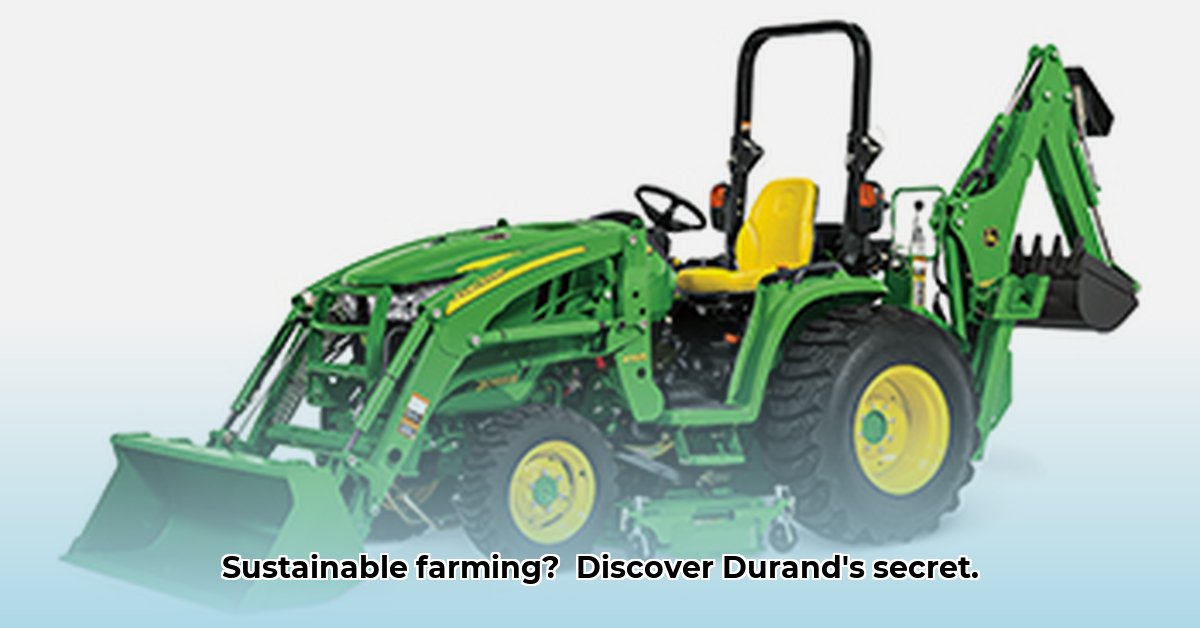
Farming in Durand faces the challenge of balancing food production with environmental stewardship. Tractor Central Durand offers a potential solution, providing farmers with the tools and expertise needed for sustainable practices. For those considering the financial aspect of equipment, check out this resource on tractor scrap value. This article explores their contribution to sustainable agriculture, identifies areas needing improvement, and offers actionable recommendations.
More Than Just Tractors: Equipment, Expertise, and Sustainable Practices
Tractor Central Durand goes beyond tractor sales, offering a comprehensive package of equipment, parts, and repair services. This holistic approach minimizes downtime, increasing efficiency and contributing to sustainable farming by maximizing harvest yields and minimizing waste. Their focus on precision agriculture technologies further optimizes resource use. But how significant are these efficiency gains? Further data is needed to quantify the exact improvements in fuel efficiency and fertilizer reduction realized by farmers utilizing their services. Are we seeing a measurable decrease in pesticide use? These are crucial questions to answer.
Precision Farming: Optimizing Resource Use Through Technology
Precision farming uses technology to fine-tune farming operations. GPS-guided equipment, for instance, allows for precise planting and spraying, reducing wasted seeds, fertilizers, and pesticides. Variable rate technology further optimizes resource allocation by adjusting application based on specific field needs. While these technologies hold great promise for sustainability, quantitative data demonstrating the actual resource savings (e.g., percentage reduction in fertilizer use, fuel consumption) achieved by Tractor Central Durand clients is lacking. This data gap needs to be addressed. How can we demonstrate the actual environmental benefit beyond theoretical claims?
Transparency and Sustainability: The Need for Data-Driven Accountability
While Tractor Central Durand facilitates sustainable practices, clearer communication concerning their own environmental impact is needed. Currently, details regarding their sustainability initiatives remain scarce. A comprehensive sustainability audit is highly recommended. This will not only highlight their environmental footprint but also quantify the positive impacts of the technologies they promote. This increased transparency will build trust with farmers, investors, and the broader community, fostering greater collaboration and ultimately, greater success in implementing sustainable practices. What are the specific steps Tractor Central is taking to reduce its own carbon footprint? This level of transparency is essential.
A Roadmap to Sustainable Agriculture: Actionable Steps for All Stakeholders
Sustainable farming hinges on collaboration. The following steps outline a path toward a brighter, greener future for Durand’s agricultural landscape:
For Tractor Central Durand:
Conduct a Comprehensive Sustainability Audit: Assess your current environmental footprint through a rigorous audit. (Efficacy Metric: Reduction in overall environmental impact measured by a recognized standard like GHG emissions per unit of production.)
Develop a SMART Sustainability Plan: Establish specific, measurable, achievable, relevant, and time-bound goals. (Efficacy Metric: Percentage reduction in key environmental impact indicators within a defined timeframe.)
Publish Sustainability Data Transparently: Share your audit findings and sustainability plan publicly to build trust and demonstrate commitment. (Efficacy Metric: Increased public confidence reflected in positive media coverage and stakeholder engagement.)
For Farmers:
Embrace Precision Agriculture Technologies: Implement these technologies to improve resource management. (Efficacy Metric: Increased yield per acre, decreased resource consumption.)
Utilize Tractor Central Durand's Expertise: Partner with them for guidance and support in adopting these technologies. (Efficacy Metric: Reduced time to implement and achieve positive results.)
For Suppliers:
Assess the Environmental Impact of Parts and Materials: Evaluate the sustainability of your supply chain. (Efficacy Metric: Percentage of materials sourced from sustainable suppliers.)
Prioritize Sustainable Sourcing: Choose suppliers committed to ethical and environmental responsibility. (Efficacy Metric: Reduction in the ecological footprint of sourced materials.)
For the Durand Community:
Promote Sustainable Agriculture Initiatives: Educate the community about environmentally responsible farming practices. (Efficacy Metric: Increased community awareness and participation in sustainable initiatives.)
Invest in Training Programs: Support programs that train workers in sustainable farming techniques. (Efficacy Metric: Number of farmers and workers trained in relevant sustainability practices.)
For Government Agencies:
Utilize Available Grants and Funding: Explore and secure government funding for initiatives supporting sustainable agriculture. (Efficacy Metric: Amount of funding secured for sustainable agriculture initiatives.)
Enact Policies that Encourage Sustainability: Introduce policies and regulations that promote environmental stewardship in agriculture. (Efficacy Metric: Number of farms adopting sustainable practices due to policy incentives.)
Mitigating Risks Associated with Precision Agriculture
Implementing new technologies always involves risks. For precision agriculture, these include equipment malfunctions, data security issues, high upfront costs, over-reliance on technology, and unforeseen environmental impacts. Proactive mitigation strategies, such as regular maintenance, robust cybersecurity measures, and careful planning, are crucial to minimize these potential challenges and ensure the responsible adoption of these technologies.
The future of farming in Durand requires a concerted effort. Tractor Central Durand, as a key player, can drive sustainable practices by focusing on data-driven decision making, transparent communication, and collaboration with all stakeholders. This collaborative approach is essential to fostering a healthier environment and a more prosperous community.